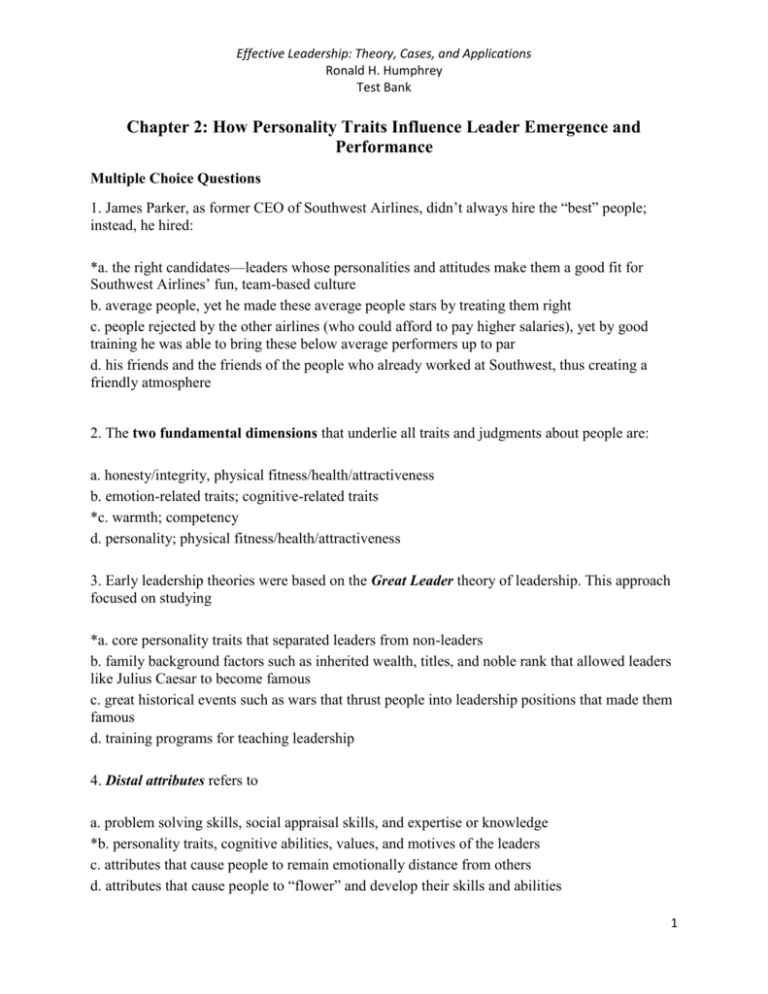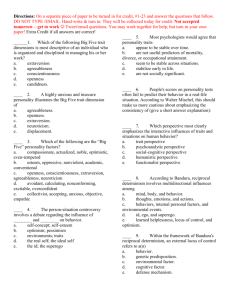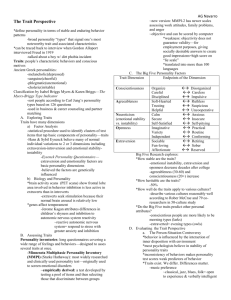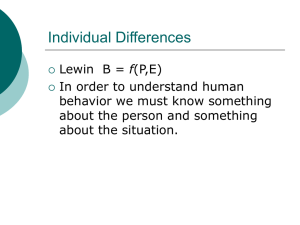Leadership Personality Test Bank: Emergence & Performance
advertisement

Effective Leadership: Theory, Cases, and Applications Ronald H. Humphrey Test Bank Chapter 2: How Personality Traits Influence Leader Emergence and Performance Multiple Choice Questions 1. James Parker, as former CEO of Southwest Airlines, didn’t always hire the “best” people; instead, he hired: *a. the right candidates—leaders whose personalities and attitudes make them a good fit for Southwest Airlines’ fun, team-based culture b. average people, yet he made these average people stars by treating them right c. people rejected by the other airlines (who could afford to pay higher salaries), yet by good training he was able to bring these below average performers up to par d. his friends and the friends of the people who already worked at Southwest, thus creating a friendly atmosphere 2. The two fundamental dimensions that underlie all traits and judgments about people are: a. honesty/integrity, physical fitness/health/attractiveness b. emotion-related traits; cognitive-related traits *c. warmth; competency d. personality; physical fitness/health/attractiveness 3. Early leadership theories were based on the Great Leader theory of leadership. This approach focused on studying *a. core personality traits that separated leaders from non-leaders b. family background factors such as inherited wealth, titles, and noble rank that allowed leaders like Julius Caesar to become famous c. great historical events such as wars that thrust people into leadership positions that made them famous d. training programs for teaching leadership 4. Distal attributes refers to a. problem solving skills, social appraisal skills, and expertise or knowledge *b. personality traits, cognitive abilities, values, and motives of the leaders c. attributes that cause people to remain emotionally distance from others d. attributes that cause people to “flower” and develop their skills and abilities 1 Effective Leadership: Theory, Cases, and Applications Ronald H. Humphrey Test Bank 5. Proximal attributes refers to *a. problem solving skills, social appraisal skills, and expertise or knowledge b. personality traits, cognitive abilities, values, and motives of the leaders c. attributes that cause people to remain emotionally distance from others d. attributes that cause people to “flower” and develop their skills and abilities 6. A meta-analysis examined the effects of distal and proximal attributes. It found that a. distal attributes predicted leader effectiveness b. proximal attributes predicted leader effectiveness c. proximal and distal attributes were both unrelated to leader effectiveness *d. both “a” and “b” 7. The dimension of the Big Five called ____________ refers to originality, creativity, and the willingness to try new experiences. a. Artistic temperament *b. Openness c. Intelligence d. Extroversion 8. Which of the Big Five personality dimensions predict to leadership effectiveness when all five are included in a multiple regression equation? a. All five predict leadership effectiveness b. All but Extraversion predict leadership effectiveness *c. Only Openness and Extraversion predicted leadership effectiveness d. All but Agreeableness predict leadership effectiveness 9. According to the case on Oprah Winfrey and J. K. Rowling, a. introverts like J. K. Rowling can be highly successful b. extraverts like Oprah Winfrey can be highly successful c. the key is to pick occupations that match your personality and skills *d. all of the above 2 Effective Leadership: Theory, Cases, and Applications Ronald H. Humphrey Test Bank 10. How does Conscientiousness relate to leadership according to the multiple regression study on personality traits and leadership? a. Conscientiousness helped people emerge as leaders b. Conscientiousness didn’t help leaders perform more effectively once Openness and Extraversion were taken into account *c. both “a” and “b” d. Conscientiousness was unrelated to leadership emergence and leadership performance 11. Core Self-Evaluations is comprised of a. Emotional Stability and Self-Esteem b. Locus of Control c. Generalized Self-Efficacy *d. All of the above 12. People with an Internal Locus of Control believe that a. outside forces—chance, fate, luck, other people—determine what happens to them *b. they determine their own destiny through their own actions and efforts c. promotions to leadership positions should be done internally whenever possible d. promotions to leadership positions should include a high mix of organizational outsiders 13. According to a study of 75 CEOs of major league baseball teams, CEOs with high Core SelfEvaluations *a. had higher team winning percentages and higher fan attendance b. had lower team winning percentages and lower fan attendance c. had inflated egos that lead to conflict and high turnover among their managers d. were rated as better leaders, but they were unable to influence team winning percentages because that depended on player abilities beyond their control 14. In the feature, Personal Reflections: Internal Locus of Control and the American Dream, the author describes how he witnessed over the years a. young entrepreneurs with good ideas get crushed by corporations with huge budgets b. corporations only promoting to CEO positions family members of rich stock holders 3 Effective Leadership: Theory, Cases, and Applications Ronald H. Humphrey Test Bank *c. corporations promoting people from middle class families to CEO roles, and entrepreneurs triumphing over large corporations d. both “a” and “b” 15. “_______________ reflects a relatively stable dispositional tendency for individuals to control situational forces and actively incite change in their environments”. a. External Locus of Control b. Conscientiousness c. High-Control Personality Type *d. Proactive personality 16. A study summarized 25 separate samples with a combined number of 5,045 participants. The study found that people with all four types of proactive personality had *a. higher performance b. average performance c. below average performance d. a wide range of psychological problems and diminished well-being 17. According to the Myers-Briggs Type Indicator® (MBTI), if when gathering data you prefer abstract data and concepts, you are an a. Openness type *b. iNtuitive c. Sensor d. Perceiver 18. According to research studies, which Myers-Briggs type has the highest leader performance? a. Thinkers b. Judgers c. Perceivers *d. There is little solid research evidence that leader performance overall varies by MBTI type 19. A review concluded that the relative proportion of ________ types increases as one goes from lower to middle to upper management. 4 Effective Leadership: Theory, Cases, and Applications Ronald H. Humphrey Test Bank a. Thinkers b. Judgers *c. iNtuitive d. Perceivers 20. According to the case comparison, Tom Monaghan (Domino’s Pizza founder) and Ted Turner (Turner Broadcasting) may both be extremely high on a. Ideological rigidity *b. Agreeableness c. Openness to Experiences d. focusing on their business interests to the exclusion of all other interests True-False Questions 21. Throughout the 20th Century, scholars uniformly recognized the value of personality traits to leadership—the overwhelming evidence in favor of traits meant that it was one of the few areas of leadership research that was accepted without skepticism. a. True *b. False 22. In terms of leadership emergence, Agreeableness was negatively related to emerging as a leader. *a.True b. False 23. Neuroticism overlaps with the other personality variables—when the other variables are not taken into account, Neuroticism is negatively correlated with both leadership emergence and effectiveness. *a. True b. False 24. Although Core Self-Evaluation sounds similar to Self-Esteem, Self-Esteem is not a component of Core Self-Evaluations and scales that measure the two constructs show no relationship between the two. a. True *b. False 5 Effective Leadership: Theory, Cases, and Applications Ronald H. Humphrey Test Bank 25. Although the concept initially seemed promising, a summary of the research studies found that proactive personality was unrelated to performance. a. True *b. False 26. Thinkers use logic and analysis to make decisions, they focus on problems and are relatively objective, and they may focus more on giving constructive feedback than on subordinates’ feelings. *a. True b. False 27. A study of derailment characteristics found virtually no difference between Extraverts and Introverts on overall derailment characteristics. *a. True b. False 28. Managers and administrators are more likely to be Thinkers and Judgers. *a. True b. False Essay Questions 29. According to the meta-analysis on the Big Five personality traits, how does ExtraversionIntroversion relate to leadership emergence and effectiveness? Compare these results to the results for the studies on the Myers-Briggs Type Indicator® (MBTI) for Introverts and Extraverts. Do you think occupational differences might influence whether Introverts or Extroverts make better leaders? If so, what occupations might be appropriate for each type? *Ans: Big Five Meta-analysis: Extraversion is important to leader performance: For leadership effectiveness, the only two important traits in the multiple regression were Openness and Extraversion—the other three were not statistically significant. Extraversion was also related to leader emergence: Extraversion was somewhat more important than Openness when predicting to leadership emergence, so its overall effect was slightly greater. This suggests that leaders need to be open to new ideas in order to develop plans and effective strategies and extraverted enough to emerge as the leader and to get others to go along with the plans. MBTI: The makers of the MBTI claim that all types are equally valid and effective. Gardner and Martinko (1996) also found no differences between Extraverts and Introverts in managerial effectiveness. They noted that there was wide variability in the percentage of Introverts and Extraverts according to the study setting; this suggests that occupational differences may be important with regard to Extraversion vs. Introversion. Thus, the key to leadership success might be to find the occupation 6 Effective Leadership: Theory, Cases, and Applications Ronald H. Humphrey Test Bank that matches one’s Extraversion or Introversion type. Another study found virtually no difference between Extraverts and Introverts on overall derailment characteristics. 30. Discuss the meta-analysis results for the effects of Conscientiousness on leader emergence and performance. How would you explain these results? *Ans: Conscientiousness helped people emerge as leaders, but it is interesting that it didn’t help leaders perform more effectively once Openness and Extraversion were taken into account. Perhaps this is because even ineffective leaders can be hard working, and what separates effective leaders most from ineffective ones is the quality of their decisions and their ability to work with others. Nonetheless, Conscientiousness still shows an important positive correlation with leadership emergence, so potential leaders need to work hard enough to get the promotion. The rest of the answer should be the student’s own thoughts about these results. 31. Compare and contrast Proactive personality and Core Self-Evaluations. How are these two concepts the same, and how are they different? *Ans: Core Self-Evaluations is a relatively new personality trait concept; however, it is comprised of four of the oldest and most frequently studied personality traits: Emotional Stability, Self-Esteem, Locus of Control, and Generalized Self-Efficacy. Judge et al. defined Core Self-Evaluations this way: Core Self-Evaluations is a higher-order concept representing the fundamental evaluations that people make about themselves and their functioning in the environment. Individuals with positive Core SelfEvaluations appraise themselves in a consistently positive manner across situations; such individuals see themselves as capable, worthy, and in control of their lives. (2004, pp. 326–327) As defined in this study (Thomas et al., 2010, p. 276), “Proactive personality reflects a relatively stable dispositional tendency for individuals to control situational forces and actively incite change in their environments” (e.g., Bateman & Crant, 1993) [italics and boldface added]. A proactive orientation may be especially important during turbulent times (Bateman & Crant, 2010, p. 276): “Proactive employees who succeed within these dynamic environments do so by realizing that they do not have to play the hand they were dealt. Rather, top performers tend to proactively create circumstances that facilitate personal and organizational success.” Proactive personality may be closely related to the internal locus of control dimension of Core Self-Evaluations, which is defined in the text this way: Locus of Control, by the way, refers to the belief that you control what happens to you. People with an External Locus of Control believe that outside forces—chance, fate, luck, other people—determine what happens to them; 7 Effective Leadership: Theory, Cases, and Applications Ronald H. Humphrey Test Bank conversely, people with an Internal Locus of Control believe that they determine their own destiny through their own actions and efforts. 8









